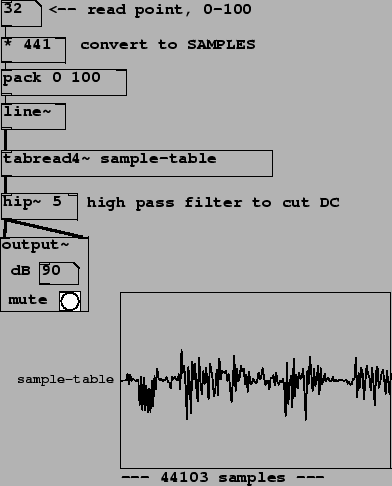 |
Patch B04.sampler.pd (Figure 2.14) shows how to use a wavetable as a
sampler. In this case the index into the sample (the wavetable) is controlled
by mousing on a number box at top. A convenient scaling for the number box is
hundredths of a second; to convert to samples (as the input of tabread4~
requires) we multiply by 44100 samples/sec times 0.01 sec to get 441 samples
per unit, before applying pack and line~ in much the same way
as they were used in the previous example.
The transposition you hear depends on how quickly you mouse up and down.
This example has introduced one new object class:
![]() :
simple high-pass (low-cut) filter. The creation argument gives the rolloff
frequency in cycles per second. We use it here to eliminate the constant
(zero-frequency)
output when the input sits in a single sample (whenever you aren't actively
changing the wavetable reading location with the mouse.) Filters are discussed
in chapter 8.
:
simple high-pass (low-cut) filter. The creation argument gives the rolloff
frequency in cycles per second. We use it here to eliminate the constant
(zero-frequency)
output when the input sits in a single sample (whenever you aren't actively
changing the wavetable reading location with the mouse.) Filters are discussed
in chapter 8.
The pack and line~ in this example are not merely to make the
sound more continuous, but are essential to making the sound intelligible at
all. If the index into the wavetable lookup simply changed every time the
mouse moved a pixel (say, twenty to fifty times a second) the overwhelming
majority of samples would get the same index as the previous sample (the
other 44000+ samples, not counting the ones where the mouse moved.) So
the speed of precession would almost always be zero. Instead of changing
transpositions, you would hear 20 to 50 cycles-per-second grit. (Try it to find out
what that sounds like!)